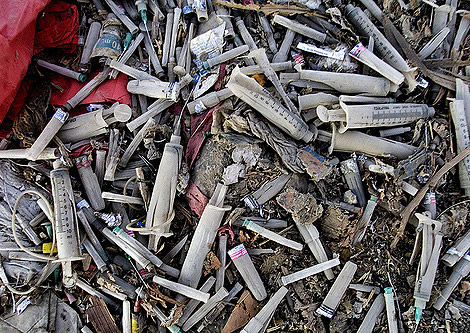 |
| Medical waste |
Medical wastes are generated as a result of patient diagnosis and/or treatment or the immunization of human beings or animals. The subset of medical waste that potentially could transmit an infectious disease is termed infectious waste.
The Centers for Disease Control (CDC), the U.S. Environmental Protection Agency (EPA), and the World Health Organization (WHO) concur that the following wastes should be classified as infectious waste: sharps (needles, scalpels, etc.), laboratory cultures and stocks, blood and blood products, pathological wastes, and wastes generated from patients in isolation because they are known to have an infectious disease.
Medical wastes can also include chemicals and other hazardous materials used in patient diagnosis and treatment. In some cases this subset of medical waste is classified as hazardous waste. Hospitals, clinics, research facilities, diagnostic labs, and other facilities produce medical waste.
  |
The bulk of the wastes generated by most health care facilities, however, is municipal solid waste (MSW), or trash. MSW includes large quantities of paper, cardboard and plastics, metals, glass, food waste, and wood. Medical waste, though a smaller portion of the total health care waste stream, is of special concern because of the potential hazards from pathogens that may be present, or from hazardous chemicals.
Risk and Health Care Waste
In the late 1980s there were a series of syringe wash ups on beaches along the East Coast of the United States, which were mistakenly attributed to health care facilities. The federal Medical Waste Tracking Act (MWTA) was passed and the EPA attempted to set standards for managing the infectious waste component of medical waste that they renamed regulated medical waste.
Few states adopted its stringent guidelines. The MWTA expired in the early 1990s, making each state responsible for establishing its own classification and management guidelines for medical waste.
There are very few documented cases of disease transmission from contact with medical waste. The notable exception is needle stick, or “sharps” injuries. Paralleling the concern over beach wash ups of medical waste, was a growing awareness of the increase in HIV-AIDS and other cases of infectious diseases being diagnosed and treated in health care settings.
This, along with a series of events, led to the Occupational Safety and Health Administration (OSHA), which established rules designed to protect health care workers (OSHA blood-borne pathogen standards and universal precautions) by stipulating the need for such personnel to wear protective clothing and equipment, and to take special precautions when handling or disposing of sharps.
The interpretation of rules surrounding worker safety regulations led to some confusion over waste classification, thus causing a greater amount of wastes to be considered as potentially infectious. (For example, under the OSHA universal precautions guidelines, a worker handling a bandage with a single drop of blood on it should wear gloves, but the waste itself would most likely not be classified as infectious).
Noting that there are multiple risks inherent in medical waste including toxic chemicals and radioactive materials, the WHO has chosen to use the term health care risk waste instead of medical waste.
Proper Management, Treatment, and Disposal
There is general consensus among professional health care organizations, the waste management industry, and regulators that proper management starts with the identification of wastes requiring special handling and treatment because of their hazardous nature (biological, chemical, or radioactive). Waste identification is necessary for proper segregation, so that only those wastes needing special treatment and handling are treated. Proper management of all waste streams enhances worker safety, protects the environment, and can reduce costs.
Wastes that are deemed potentially infectious may be treated prior to disposal by a number of different technologies that either disinfect or sterilize them. These technologies include incineration, steam sterilization, dry heat thermal treatment, chemical disinfection, irradiation, and enzymatic (biological) processes among others. In 2002 there were more than one hundred specific technologies in use. In order for treatment systems to work properly, distinctive protocols for the classification and segregation of wastes must be in
place.
Most treatment technologies for infectious wastes cannot process chemical or radioactive waste. Misclassification and inappropriate treatment of infectious wastes can result in significant harm to the environment and human health; for example, residual chemotherapeutic agents are should not be treated in autoclaves, but rather should be set aside and treated by either incineration (hazardous waste incinerators) or chemically neutralized where feasible.
The EPA has cited medical waste incinerators as among the top sources of mercury and dioxin pollution. New regulations governing the operation of, and emissions from, medical waste incinerators in the late 1990s have resulted in the closure of most such incinerators in the United States. Other countries such as the Philippines have completely banned incineration because of its adverse environmental impacts.
The health care industry is rapidly changing in ways that continue to have significant impact on the volume and characteristics of wastes produced.
- New (e.g., laproscopic and laser) surgical techniques result in procedures that produce very little blood-contaminated waste.
- Advances in cancer treatment have produced many drugs used in chemotherapy that are highly toxic in small quantities, producing more hazardous chemical wastes.
- Patient residence time in hospitals has declined. Procedures that previously required an extended stay now commonly occur on an outpatient basis without necessitating an overnight stay.
- Home care continues to grow, shifting the location of service delivery. Dialysis, chemotherapy, and hospice care are but a few examples of health care that often take place in a home setting, the result being that many wastes regulated as infectious or hazardous waste in a hospital are being disposed of as ordinary trash at curbside. (Household waste is exempt from many regulations.)
- As hospitals close their incinerators, biohazardous and sometimes (inadvertently) hazardous wastes are being hauled significant distances to centralized facilities for treatment and disposal.
All of these changes represent new challenges in continuing efforts to properly define, classify, regulate and manage medical wastes.